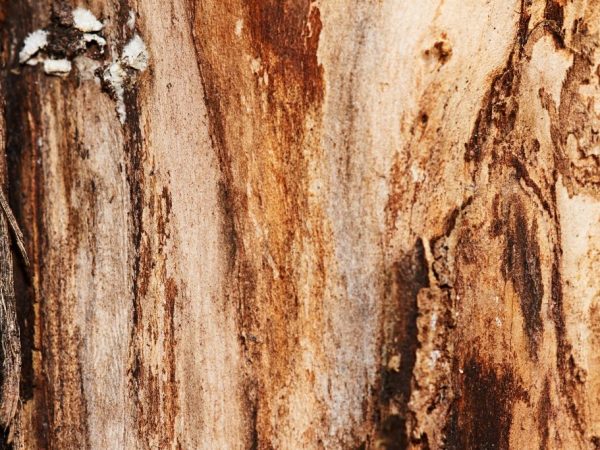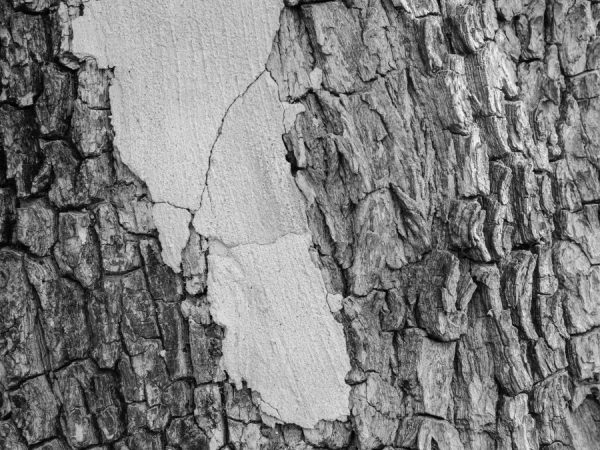Reasons for peeling the bark of an apple tree
When the bark of an apple tree falls off, this can be due to several reasons. Cracks in the trunk are often a sign of diseases that, in the absence of timely treatment, lead to a decrease in yield and even death of the tree.

Reasons for peeling the bark of an apple tree
Factors Affecting Detachment
To understand why cracks appeared on the tree bark, why it peels off, peels off and falls off, allows a thorough examination of the garden culture and a detailed study of splits, as well as other changes in the state of the wood associated with damage.
Diseases
When the bark of an apple tree not only cracks, but also blackens and dries, and its structure is loose and covered with a brown-black bloom, these are most likely the first signs of black cancer. It is caused by a sooty fungus, and the disease instantly spreads through the tree.
When an infection occurs, not only the trunks become damaged, but also the fruits with foliage. Black crayfish can destroy a garden culture in 3-4 years.
Animals and pests
If the bark of fruit trees is cracked and bare, this is the first sign that rodents or hares have eaten it. Peeling wood in places where the bark peels off on an apple tree becomes the site of infection.
The tree bark also peels off due to the defeat of the bark beetle. The pest penetrates through mechanical damage and wounds to where the dead wood burst, peeled off or falls behind, and settles there. Most often, it affects weakened and old fruit trees with reduced immunity.
The first signs of the pest settling are the numerous passages made by the beetle in places where the wood exfoliates.
Yellow lichen appears on sufficiently mature apple trees. The older the tree, the higher the risk of being hit by it. The place of its settlement is the trunk and branches. Contributing factors are high humidity and low temperatures.
If the apple tree is not cleaned of lichen, it will soon cause the development of a fungus, which after a while will begin to decompose the tree bark.
Temperature drops
When the bark bursts on an apple tree and leaves it without visible signs of a pest or disease, the cause of damage can be sharp temperature fluctuations day and night. This situation is especially often observed in the spring.
Cracks from the effects of temperature changes in description and the nature of their appearance differ from those that occur due to damage by parasites or diseases. Trunks and branches crack laterally.
The causes of cracking and flaking of wood are often severe frosts or, conversely, persistent heat. Weakly winter-hardy trees grown in waterlogged soil or planted too deep are at risk.
Improper care
The cause of cracking on apple wood is also the improper care of the garden culture:
- lack of mineral elements and lack of moisture, while the bark bursts and leaves, and ripening fruits dry out;
- incorrect pruning and poor-quality subsequent disinfecting processing of sections.
Often in the rainy autumn season, shoots actively growing in young apple trees are covered with cracks along the trunk. The reason for this is the lack of elasticity of the wood during its rapid growth.
Mechanical treatment

Carefully repair the damage
The scheme for treating an apple tree with damage to the bark involves a number of standard measures:
- in places where the wood has cracked, remove the exfoliated fragments;
- lesions, where the bark cracked and fell off, are cleaned with a tool (iron brush), which is disinfected in advance;
- at the end of the procedure, the affected areas must be treated with brilliant green, hydrogen peroxide, potassium permanganate;
- to avoid infection, the wound is covered with garden pitch.
When cleaning damaged areas, be careful not to touch healthy layers of wood.
With disease
When the appearance of cracks in the bark of an apple tree is associated with a lesion with a disease (it has turned black and lagged behind due to a fungus), the treatment of a garden culture should be started immediately:
- first, the areas of the bark and branches affected by the fungus are removed and burned, which have black spots on the surface;
- the wounds are covered with linseed oil or garden varnish;
- the surviving branches are subject to treatment with copper sulfate with a concentration of 3% or with a solution of raspberry-colored potassium permanganate.
At the end of flowering, the apple tree needs to be treated with 1% Bordeaux liquid.
If damaged by animals
If animals gnawed the apple tree, small-sized damage, where the wood fell off and peeled off, is covered with garden pitch. When the affected area is extensive, the fruit crop can be restored in spring by grafting:
- healthy cuttings cut from the middle or on top of the apple tree are inserted into the bark with one end above the wound, and with the other below, resulting in a bridge-like structure;
- the ends are fixed, coated with garden pitch, moss is spread on top and covered with burlap.
The inserted cuttings will aid in the movement of the sap, providing nourishment. This will help preserve the tree.
When damaged by a pest
When a bark beetle settles under the layers of wood, it is not possible to save the tree with extensive damage. If no more than 2-3 holes are made for them, the apple tree can be helped by cutting off the affected branches.
With an extensive settlement of the pest, mechanical methods of control do not help and treatment is carried out using chemicals.
With temperature drops
Whitewashing of boles allows protecting apple trees from bark cracking due to temperature fluctuations.
For greater efficiency, the garden culture is recommended to be treated with whitewash, to which copper sulfate or mullein is added - 100-300 ml per 10 liters of water.
It is especially important to protect young shoots of fruit trees during the rainy season, when the bark lacks elasticity. For these purposes, the trunk is treated with iron sulfate with a concentration of 3% before whitewashing.
It is also permissible in young seedlings at the stage of active growth of shoots with a sharp knife along the trunk from the bottom up to make a longitudinal incision, which will allow the bark to disperse by 1-2 mm. The restoration of the cut takes place in a short period and does not cause severe damage to the garden culture.
Treatment with chemicals
Chemicals are used when diseases and pests are the causes of cracking and flaking of apple bark.
Against the bark beetle
From the appearance of the pest in the cracks of the bark, insecticide treatments are used. With the help of a medical syringe, they are poured into the hole made by the bark beetle and, after complete absorption, they are covered with garden var.
Effective drugs include "Calypso", "Antizhuk", "Antishashelin" and the like.
Against infections
In the fight against fungal infection:
- cut damage to a healthy layer of wood;
- watering lesions with 5% iron or 2% copper sulfate;
- the wounds are covered with putty;
- the trunk is whitewashed.
Prophylaxis
Preventive measures keep apple wood intact and healthy. Preventive methods that can protect the tree from cracking and peeling of the bark include:
- whitewashing the trunk before the winter season;
- thorough cleaning of plant debris;
- digging soil near the trunk circle;
- in the spring, before flowering, to increase immunity, the apple tree is fed with a fertilizer complex containing boron and magnesium;
- hilling trees in winter with snow;
- in regions with a cold climate, frost-resistant apple varieties are planted.

